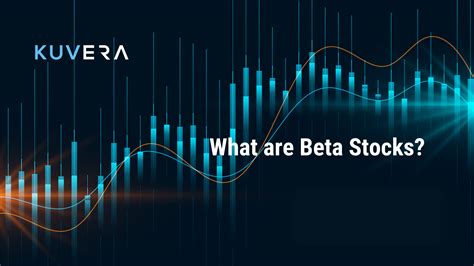Introduction
In the ever-evolving landscape of financial markets, understanding the nuances of stock beta has become paramount for navigating the treacherous waters of risk and return. Stock beta, a measure of a stock’s volatility relative to the overall market, plays a crucial role in portfolio construction and investment strategy. This comprehensive guide delves into the intricacies of stock beta, empowering investors with the knowledge to harness its power for optimal financial outcomes.

Understanding Stock Beta
Definition
Stock beta quantifies the sensitivity of a stock’s price movements to the fluctuations of the broader market. It is a measure of systematic risk, also known as non-diversifiable risk, inherent in the stock. A beta of 1.0 indicates that the stock’s price moves in tandem with the market, while a beta of 2.0 suggests that it is twice as volatile as the market.
Interpreting Beta Values
Positive Beta: Stocks with a positive beta move in the same direction as the market. When the market rises, so do these stocks, and when the market falls, their prices typically decline. The magnitude of the beta indicates the strength of the correlation.
Negative Beta: Stocks with a negative beta move in the opposite direction of the market. As the market rises, these stocks tend to fall in value, and vice versa. This negative correlation can provide downside protection to portfolios.
Beta and Risk
Risk Assessment
Beta serves as a proxy for risk, as it measures the volatility of a stock relative to the market. Stocks with higher betas are more volatile and therefore carry a higher level of risk. Investors seeking growth and potential higher returns may opt for stocks with higher betas, while those prioritizing safety and stability may prefer stocks with lower betas.
Risk Diversification
Diversification, a key principle of investing, aims to reduce risk by spreading investments across different assets. Understanding stock betas helps investors identify the correlation between individual stocks and the market. By carefully selecting stocks with varying betas, investors can construct portfolios that minimize systematic risk.
Beta in Practice
Portfolio Construction
Beta plays a pivotal role in portfolio construction. Investors seeking aggressive growth may allocate a higher proportion of their portfolio to stocks with high betas, potentially amplifying returns but also increasing risk. Conversely, those with a more conservative approach may favor stocks with low betas, reducing volatility and providing a buffer against market downturns.
Risk-Reward Trade-off
The relationship between beta and expected return hinges on the efficient market hypothesis. According to this theory, higher-beta stocks should offer higher expected returns to compensate investors for the increased risk. However, empirical evidence suggests that this relationship is not always linear. Nonetheless, beta remains a useful tool for assessing the risk-reward profile of individual stocks.
Beta and the Market
Market Volatility
Market volatility, as measured by the CBOE Volatility Index (VIX), significantly impacts stock betas. During periods of high volatility, stock betas tend to rise, as stocks become more susceptible to market fluctuations. Conversely, in low-volatility environments, betas typically decline.
Sector and Industry Effects
Sector and industry factors can influence stock betas. Companies operating in cyclical industries, such as manufacturing or retail, often exhibit higher betas than those in defensive sectors, like utilities or consumer staples. Similarly, large-cap stocks tend to have lower betas than small-cap stocks due to their greater market capitalization and lower volatility.
Beta in the Digital Age
Big Data and Beta Estimation
The advent of big data has revolutionized beta estimation. Algorithmic models can now analyze vast amounts of historical data to predict stock betas with greater accuracy. This enables investors to make more informed decisions and adapt their portfolios accordingly.
Artificial Intelligence and Beta Forecasting
Artificial intelligence (AI) techniques are employed to forecast stock betas and identify potential market trends. AI-powered algorithms can process complex data sets and identify patterns that are invisible to human analysts. This advanced technology enhances the ability to assess risk and make timely investment decisions.
4 Useful Tables
Table 1: Beta Ranges by Stock Type
| Stock Type | Beta Range |
|---|---|
| Large-Cap Stocks | 0.70 – 1.20 |
| Mid-Cap Stocks | 1.00 – 1.50 |
| Small-Cap Stocks | 1.20 – 2.00 |
Table 2: Sector Betas
| Sector | Beta |
|---|---|
| Utilities | 0.40 – 0.60 |
| Consumer Staples | 0.60 – 0.80 |
| Industrials | 1.00 – 1.20 |
| Technology | 1.20 – 1.50 |
| Energy | 1.50 – 2.00 |
Table 3: Historical Beta Values of Major Indices
| Index | Beta (2020-2022) |
|---|---|
| S&P 500 | 1.02 |
| Nasdaq Composite | 1.35 |
| Dow Jones Industrial Average | 0.87 |
Table 4: Beta and Expected Return (Empirical Evidence)
| Beta Range | Expected Return |
|---|---|
| 0.50 – 1.00 | 8% – 10% |
| 1.00 – 1.50 | 10% – 12% |
| 1.50 – 2.00 | 12% – 15% |
Conclusion
Understanding stock beta is essential for investors navigating the complexities of financial markets. Beta provides insights into a stock’s volatility relative to the market, assisting investors in risk assessment, portfolio construction, and strategic decision-making. As technology continues to advance, new applications for beta estimation and forecasting emerge, empowering investors with even greater capabilities. By embracing the power of beta, investors can harness risk and optimize returns, achieving their financial goals in a dynamic and ever-evolving investment landscape.


